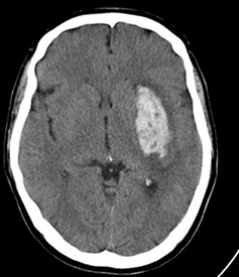Q. The following factors are likely to reduce the benefit of thrombolysis? Choose True or False for each of the 10 questions below.
Jimmy comes back from the CT scanner. Here is his scan.

Q. Should Jimmy have thrombolysis and/or thrombectomy? Select either True or False from the options below.
Q. The following factors are likely to reduce the benefit of thrombolysis?
More severe stroke – False – although although the risk of bleeding is higher with severe stroke, this increased risk is offset by the greater benefits in severe stroke.
Shorter interval since last well – False – if the interval is shorter the benefits are greater.
Taking an oral anticoagulant – True – this will be associated with a greater risk of bleeding, and reduced benefit.
Greater age – False – the elderly gain at least as much benefit from thrombolysis as younger people.
Recent history of stroke – True – a recent history of stroke has been associated with a greater risk of intracerebral bleeding after thrombolysis, and therefore reduced benefit.
Systolic blood pressure above 180mmHg – True – very high BP is perceived as being riskier, and thus potentially reducing the benefits of thrombolysis.
Epileptic seizure since onset – True – an epileptic seizure may mimic a stroke, or make it appear more severe than it actually is – therefore the benefit of thrombolysis may be less.
Recent trauma, operation or bleeding – True – this may increase the risk of bleeding, and reduce the benefits.
Taking an oral contraceptive – False – there is no evidence this reduces the benefit.
BM stick is very High (>22mmol/l) – True – a very high or low BM can be associated with focal neurological symptoms which may mimic a stroke, so that thrombolysis may not be of any benefit. Also, some concern that very high BM may increase risk of bleeding.
Q. Should Jimmy have thrombolysis and/or thrombectomy?
The CT scan shows no abnormality- False – it shows a large are of high density (white) on the left side of his brain.
This is the appearance of an acute intracerebral bleed – True – an ischaemic stroke might not be visible in the first few hours, and if it is, it appears darker (darker grey) than the surrounding brain.
Jimmy should be treated with thrombolysis – False – this would be very dangerous and would be likely to kill Jimmy.


